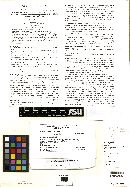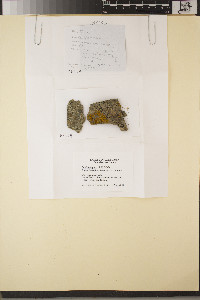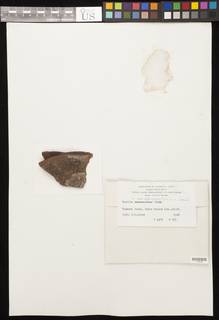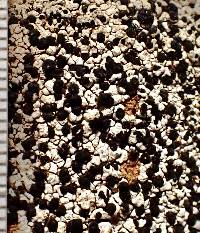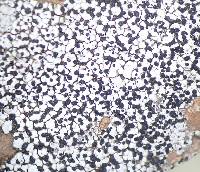
- Home
- Search
- Images
- Species Checklists
- US States: O-Z >
- US National Parks
- Central America
- South America
- US National Parks
- Southern Subpolar Region
|
|
|
|
Family: Caliciaceae
[Buellia excelsa (Leight.) A.L. Sm., moreBuellia lepidastroidea Imshaug ex Bungartz, Buellia punctata var. excelsa (Leight.) Sheard, Lecidea sequax Nyl.] |
Nash, T.H., Ryan, B.D., Gries, C., Bungartz, F., (eds.) 2007. Lichen Flora of the Greater Sonoran Desert Region. Vol 3. Please note the publication by Giralt, M., F. Bungartz & J. A. Elix 2011: The identity of Buellia sequax. Mycological Progress 10(1): 115-119. The description below (originally published for B. lepidastroidea) applies to Buellia sequax s.str. Thallus: crustose, areolate to subsquamulose, or bullate, thin to moderately thickened, ±continuous or becoming dispersed; prothallus: delimiting the thallus margin, distinctly blackened to pale gray, rarely white and indistinct surface: usually ivory, rarely beige, dull, smooth, epruinose or with a fine pruina, phenocorticate, esorediate medulla: white, lacking calcium oxalate (H2SO4-) Apothecia: lecideine; (0.3-)0.5-0.8(-1.1) mm in diam., soon sessile margin: black, thin, rarely persistent, usually excluded with age disc: black, epruinose, plane, soon becoming convex proper exciple: dispersa-type, inner excipular hyphae distinct, not reduced, pigmented, prosoplectenchymatous (textura oblita), extending from the deep reddish brown hypothecium (leptoclinoides-brown, textura intricata), outer excipular hyphae short-celled, cells angular, distinctly swollen (textura angularis) and usually ±carbonized with various amounts of a brown pigment (cf. elachista-brown, HNO3-) epihymenium: brown, pigmentation continuous with the outer exciple (HNO3-) hymenium: hyaline, inspersed with oil droplets; paraphyses: simple to moderately branched, apically swollen, with a brown pigment cap (cf. elachista-brown) asci: clavate, Bacidia-type, 8-spored ascospores: soon brown, 1-septate, oblong to ellipsoid, usually not constricted, with obtuse ends, not curved, (7-)11.4-[13.2]-15(-17) x (5-)6-[6.7]-7.4(-8) µm (n=60); proper septum: becoming soon but only briefly thickened during spore ontogeny, without lateral wall thickenings (±Physconia-type); ornamentation: not visible in DIC Pycnidia: rare, urceolate to globose, unilocular; ontogeny similar to the Umbilicaria-type conidiogenous cells: mostly terminal, rarely also intercalary (cf. conidiophore-type V) conidia: bacilliform, 2-7 x 1-2 µm (n=41) Spot tests: K+ yellow, P+ orange, C-, KC-, CK- fluorescence: UV+ pale ivory iodine reaction: medulla non-amyloid Secondary metabolites: atranorin, chloroatranorin, diploicin, 3-dechlorodiploicin, fulgidin, and isofulgidin (J. A. Elix, HPLC). Substrate and ecology: epilithic, on a variety of siliceous (HCl-) rock substrates World and Sonoran distribution: common along the coast of southern California, Baja California, and Baja California Sur. Notes: The taxonomy of B. sequax remains not well resolved. In the Sonoran Flora, the species was treated as B. lepidastroidea, but following Giralt & Bungartz (2011) both Buellia lepidastroidea and Buellia excelsa are now considered a synonym of B. sequax, whereas the description of B. sequax in the Sonoran Flora applies to Buellia abstracta. Buellia jorgensis Zahlbr., and Buellia boergesenii Imshaug are two additional species that belong to the "Buellia excelsa"-group for which the taxonomic affinity remains unknown. |
|
|
|



